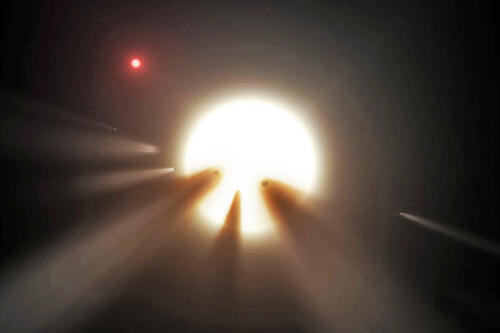|
15 January 2016 from NewScientist Website
The weirdest star in the cosmos just got
a lot weirder. And yes, it might be aliens.
Proposed explanations ranged from a
cloud of comets to orbiting "alien megastructures".
But Tabby's star dipped erratically
throughout the four years, sometimes losing as much as 20 per cent
of its brightness.
Space oddity
In September, a team led by Tabetha Boyajian of Yale University, who lends the star its informal name, tried to make sense of this unusual signal.
Ultimately they determined that dust from a large cloud of comets was the best explanation.
A month later, the star made headlines across the globe thanks to a paper by Jason Wright of Pennsylvania State University and his colleagues, who suggested that "alien megastructures" (see The Signatures and Information Content of Transiting Megastructures), such as satellites designed to collect light from the star, could be responsible for the signal.
Now Bradley Schaefer of Louisiana State University has discovered that the mystery goes even further.
When Boyajian's team studied the star, they looked at data from a Harvard University archive of digitally scanned photographic plates of the sky from the past century or so to see if the star had behaved unusually in the past, but found nothing.
Schaefer decided this unusual star deserved a second look.
He averaged the data in five-year bins to look for slow, long-term trends, and found that the star faded by about 20 per cent between 1890 and 1989.
Starman
To confirm the fade was real, Schaefer went to Harvard to look at the original photographic plates and inspected them by eye for changes, a skill few astronomers possess these days.
Schaefer saw the same century-long dimming in his manual readings, and calculated that it would require 648,000 comets, each 200 kilometers wide, to have passed by the star - completely implausible, he says.
What about those alien megastructures?
Schaefer is unconvinced.
What's more, such an object should radiate light absorbed from the star as heat, but the infrared signal from Tabby's star appears normal, he says.
There's no doubt KIC 8462852 is behaving strangely, so something must be responsible, says Schaefer.
Reference
|


